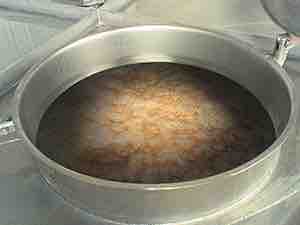Fermentation in food processing typically is the conversion of carbohydrates to alcohols and carbon dioxide or organic acids using yeasts, bacteria, or a combination thereof, under anaerobic conditions. Fermentation in simple terms is the chemical conversion of sugars into ethanol. The science of fermentation is also known as zymology or zymurgy.
Historically, when studying the fermentation of sugar to alcohol by yeast, Louis Pasteur concluded that the fermentation was catalyzed by a vital force, called "ferments," within the yeast cells. The "ferments" were thought to function only within living organisms. "Alcoholic fermentation is an act correlated with the life and organization of the yeast cells, not with the death or putrefaction of the cells," he wrote.
Fermentation usually implies that the action of microorganisms is desirable. This process is used to produce alcoholic beverages such as wine, beer , and cider. Fermentation is also employed in the leavening of bread (CO2 produced by yeast activity); in preservation techniques to produce lactic acid in sour foods such as sauerkraut, dry sausages, kimchi, and yogurt; and in the pickling of foods with vinegar (acetic acid).

Beer
This is beer fermenting at a brewery.
Food fermentation has been said to serve five main purposes:
1. Enrichment of the diet through development of a diversity of flavors, aromas, and textures in food substrates.
2. Preservation of substantial amounts of food through lactic acid, alcohol, acetic acid, and alkaline fermentations.
3. Biological enrichment of food substrates with protein, essential amino acids, essential fatty acids, and vitamins.
4. Elimination of antinutrients.
5. A decrease in cooking time and fuel requirement.